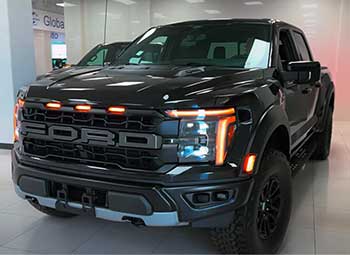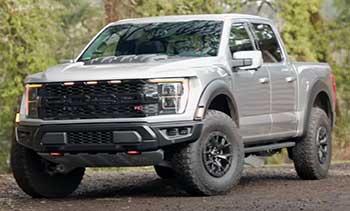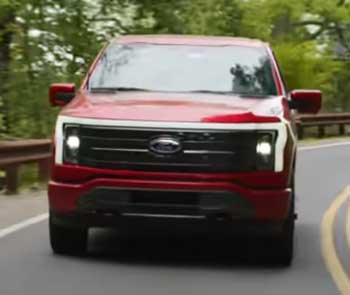
I’ve always been a truck guy, drawn to the raw power and versatility of pickups.
When it came to choosing between the Ford F-150 Raptor and the Ford F-150 Lightning, I found myself torn between two beasts with wildly different souls—one a gas-powered off-road titan, the other an electric powerhouse built for modern efficienc.
My goal here is to break down their strengths, weaknesses, and unique vibes, sharing my hands-on experience to help you decide which truck fits your life.
Through detailed pros, cons, and a side-by-side comparison, I’ll unpack what makes these Fords special and guide you toward the right choice.
| Feature | Ford F-150 Raptor | Ford F-150 Lightning |
|---|---|---|
| Powertrain | 3.5L V6 EcoBoost or 5.2L V8 (Raptor R) | Dual electric motors |
| Horsepower | 450 hp (Raptor), 720 hp (Raptor R) | 452 hp (Standard), 580 hp (Extended) |
| Torque | 510 lb-ft (Raptor), 640 lb-ft (Raptor R) | 775 lb-ft |
| Drivetrain | 4WD | AWD |
| Base Price (2023) | ~$79,415 (Raptor), ~$109,145 (Raptor R) | ~$51,990 (Pro), ~$93,040 (Platinum) |
| EPA Range | N/A (14 mpg city, 18 mpg highway) | 230-320 miles |
| Towing Capacity | 8,200 lbs (Raptor), 8,700 lbs (Raptor R) | 7,700 lbs (Standard), 10,000 lbs (Extended) |
| Payload Capacity | 1,400 lbs | 1,800-2,000 lbs |
| 0-60 mph | ~5.5 seconds (Raptor), ~4.5 seconds (Raptor R) | ~4.0 seconds (Platinum) |
| Ground Clearance | 12-13.1 inches | ~8.5-9.4 inches |
| Primary Use | Off-road performance | On-road efficiency, daily driving |
My Experience With The Ford F-150 Raptor
Driving the Ford F-150 Raptor feels like piloting a beast built for adventure. The first time I took one off-road, bouncing over rocky trails in Texas, I was hooked. Its high-output 3.5L V6 EcoBoost engine (or the monstrous 5.2L V8 in the Raptor R) delivers a roar that’s pure adrenaline.
With 450 horsepower in the standard Raptor and a jaw-dropping 720 in the Raptor R, this truck doesn’t just move—it charges. The 10-speed automatic transmission shifts smoothly, and the four-wheel-drive system grips like a mountain goat. I pushed it through mud, sand, and steep inclines, and the Fox Live Valve shocks soaked up every jolt, making rough terrain feel like a playground.
On the pavement, the Raptor’s a bit of a show-off. Its aggressive stance, flared fenders, and massive 35-inch tires (or optional 37s) turn heads everywhere. The interior’s a mix of rugged and refined, with a 12-inch touchscreen, comfy Recaro seats, and enough space to stretch out.
But it’s not all perfect—its size makes parking lots a hassle, and the fuel economy (14 mpg city, 18 highway) had me wincing at the pump. Still, the Raptor’s ability to switch from daily driver to off-road warrior is unmatched. Whether I was hauling gear or chasing thrills, it delivered a grin-inducing experience every time.
The Raptor R takes things to another level. I had a chance to test one briefly, and its supercharged V8 felt like a Mustang GT500 stuffed into a truck. The exhaust note in Baja mode is pure thunder, and it’s a beast off-road, tackling dunes with ease. But at $109,145, it’s a splurge reserved for serious enthusiasts. For most, the standard Raptor’s balance of power and price makes it the sweet spot.
My Experience With The Ford F-150 Lightning
The Ford F-150 Lightning is a different animal—quiet, smooth, and futuristic. My first drive in the Lightning Platinum was a revelation. With 580 horsepower and 775 lb-ft of instant torque from its dual electric motors, it launched me back in my seat, hitting 0-60 mph in about 4 seconds.
The extended-range battery offers up to 320 miles of range, though I found real-world numbers closer to 230-250 miles in mixed driving. On city streets, the all-wheel-drive system and independent rear suspension made it feel nimble for its size, hugging corners better than I expected from a truck.
The Lightning’s interior is a tech lover’s dream. The 15.5-inch touchscreen dominates the dash, and features like BlueCruise hands-free driving made highway trips a breeze. The frunk (front trunk) is a game-changer, offering 14.1 cubic feet of lockable storage—perfect for groceries or tools.
I used the onboard power outlets to run a worksite, which felt like cheating in the best way. But range anxiety crept in during a towing test. Hauling a 6,100-pound trailer dropped the range to about 100 miles, forcing me to plan stops carefully. For daily commuting and light duties, though, the Lightning’s efficiency and low maintenance costs make it a practical choice.
The Lightning’s vibe is less “conquer the wild” and more “master the everyday.” It’s a truck for those who want performance without the gas station visits. Still, its lower ground clearance and weight (around 6,000 lbs) limit its off-road chops compared to the Raptor. It’s a street king, not a desert runner.
Pros Of The Ford F-150 Raptor

- Off-Road Prowess: The Raptor’s Fox Live Valve shocks, skid plates, and 35- or 37-inch all-terrain tires make it a beast on any terrain. I tackled rocky hills and sandy washes without breaking a sweat.
- Powerful Engines: The 450-hp V6 or 720-hp V8 (Raptor R) deliver thrilling acceleration. The Raptor R’s supercharged V8 is a standout, offering sports-car-like speed.
- Aggressive Styling: Its bold grille, flared fenders, and high ground clearance (up to 13.1 inches) give it a commanding presence. It’s a truck that screams confidence.
- Versatile Drive Modes: From Baja to Sport to Normal, the Raptor adapts to any situation. I loved switching to Rock Crawl for tricky trails—it’s like the truck thinks for you.
- Spacious Interior: The SuperCrew cab offers ample room, and the Recaro seats are supportive yet plush. It’s a great place to spend hours, on- or off-road.
- Towing and Payload: With up to 8,700 lbs of towing (Raptor R) and 1,400 lbs of payload, it handles heavy loads well, though not as much as a standard F-150.
The Raptor’s off-road capability is its biggest draw. I took it to a rally course and felt invincible, the suspension eating up bumps like they were nothing. The V8 in the Raptor R adds a visceral thrill, but even the V6 feels plenty potent. The drive modes let me fine-tune the experience, whether I was cruising highways or blasting through mud. The interior’s rugged charm, with durable materials and a driver-focused cockpit, makes it feel special. It’s not just a truck—it’s an adventure machine.
Read more: My Thoughts on GMC Terrain Vs. Ford Escape.
Cons Of The Ford F-150 Raptor
- Poor Fuel Economy: At 14 mpg city and 18 highway (10/15 for Raptor R), it’s a gas guzzler. My wallet felt the sting after a week of mixed driving.
- High Price Tag: Starting at $79,415, and climbing to $109,145 for the Raptor R, it’s a premium purchase. You’re paying for performance, not practicality.
- Cumbersome Size: Its wide stance and long wheelbase make tight spaces a challenge. Parking in urban areas was a constant negotiation.
- Limited Towing Compared to F-150: The Raptor’s 8,200-8,700 lbs towing capacity is solid but lags behind the standard F-150’s 14,000 lbs.
- Noisy Cabin at Speed: Highway driving brings noticeable wind and tire noise, especially with 37-inch tires. It’s not the quietest ride for long trips.
- Maintenance Costs: High-performance parts like Fox shocks and big tires mean pricier upkeep. I braced myself for steep repair bills down the road.
The Raptor’s thirst for fuel was a constant reminder of its ICE roots. I averaged about 15 mpg, which hurt during long drives. Its size made city navigation tricky—I scraped a curb more than once. The high cost, especially for the Raptor R, feels like a luxury tax, and I worried about long-term maintenance for specialized components. If you don’t need off-road dominance, the Raptor’s drawbacks might outweigh its charms.
Maintenance Tips For The Ford F-150 Raptor
- Regular Tire Inspections: Check the 35- or 37-inch all-terrain tires for wear and proper pressure (around 40 psi cold). I rotate mine every 6,000 miles to ensure even wear, especially after off-roading.
- Suspension Checks: The Fox Live Valve shocks are critical for performance. Inspect for leaks or damage every 10,000 miles, and clean debris after off-road trips to avoid wear.
- Oil Changes: Use synthetic 5W-30 oil and change every 5,000-7,500 miles, especially if you push the V6 or V8 hard. I noticed smoother performance with consistent oil changes.
- Clean Air Filters: Off-roading kicks up dust, so check the air filter every 3,000 miles and replace it if clogged. A clean filter keeps the engine breathing easy.
- Check Skid Plates: Ensure skid plates are secure after rough trails. I tighten bolts every few off-road trips to prevent rattles or damage.
- Monitor Transmission Fluid: The 10-speed automatic needs fresh fluid every 50,000 miles. I check levels monthly to catch leaks early, especially after heavy towing.
- Brake Maintenance: The Raptor’s weight and performance stress brakes. Inspect pads every 15,000 miles and replace rotors if glazed to maintain stopping power.
Keeping the Raptor in top shape requires diligence, especially if you’re hitting trails regularly. I learned to stay on top of tire and suspension maintenance after a rocky outing left me with uneven tread wear. Oil changes are non-negotiable for the high-output engines, and I budget for premium fluids to keep things running smoothly. Cleaning the air filter after dusty runs saved me from power loss, and checking skid plates kept the undercarriage protected. These steps ensure the Raptor stays ready for whatever I throw at it.
Pros Of The Ford F-150 Lightning

- Instant Torque: The 775 lb-ft of torque hits instantly, making the Lightning feel like a rocket. I outran sports cars at stoplights with ease.
- Impressive Range: The extended-range battery offers up to 320 miles, ideal for daily driving. I got 250 miles in real-world conditions, plenty for most trips.
- Frunk Utility: The 14.1-cubic-foot front trunk is lockable and weatherproof. I used it for tools, groceries, and even camping gear, keeping the bed free.
- Low Running Costs: No gas means big savings. I spent about $2.50 per 100 miles charging at home, compared to $10+ for a gas truck.
- Tech-Packed Interior: The 15.5-inch touchscreen and BlueCruise hands-free driving made long drives effortless. The interface is intuitive and responsive.
- Smooth Ride: The independent rear suspension absorbs bumps better than most trucks. City streets felt like gliding, even with a full load.
The Lightning’s electric powertrain is a game-changer. Its acceleration is addictive, and the range covers most of my daily needs without worry. The frunk is a practical touch I didn’t know I needed, and charging at home slashed my fuel costs. The tech, especially BlueCruise, made highway commutes almost too easy. For urban or suburban drivers, the Lightning’s blend of power, efficiency, and comfort is hard to beat.
Cons Of The Ford F-150 Lightning
- Limited Towing Range: Towing a 6,100-pound trailer cut my range to ~100 miles. Long hauls require careful planning and frequent charging stops.
- Charging Infrastructure: Fast chargers aren’t always trailer-friendly, and home charging setup costs ($2,000+) can sting if your panel needs an upgrade.
- Weaker Off-Road Capability: With 8.5-9.4 inches of ground clearance, it’s not built for serious off-roading. I avoided rough trails to protect the undercarriage.
- Heavy Weight: At ~6,000 lbs, it feels hefty in tight turns. I noticed more body roll than expected in sharp corners.
- High Top-End Price: The Platinum trim’s $93,040 price tag rivals the Raptor R. You’re paying for tech and range, not off-road prowess.
- Battery Degradation Concerns: Long-term battery health is a question mark. I worried about replacement costs after the 8-year warranty expires.
The Lightning’s towing range was a letdown for long hauls, forcing me to unhitch at chargers, which was a hassle. Its weight made it less agile than I’d hoped, and off-road limitations kept me on pavement. The high-end trims are pricey, and I couldn’t shake concerns about battery longevity. If you tow often or venture off-road, these cons might steer you elsewhere.
Also read: My Thoughts on Ford Edge Vs. Hyundai Tucson.
Maintenance Tips For The Ford F-150 Lightning
- Monitor Battery Health: Check battery charge levels via the FordPass app and avoid draining to 0%. I keep mine between 20-80% to extend battery life.
- Tire Maintenance: Rotate tires every 7,500 miles and maintain 42 psi for optimal efficiency. I noticed better range with properly inflated tires.
- Cooling System Checks: The battery cooling system is vital. Inspect coolant levels every 10,000 miles to prevent overheating during heavy use.
- Brake Care: Regenerative braking reduces wear, but inspect pads every 20,000 miles. I cleaned brake dust regularly to maintain performance.
- Software Updates: Keep the truck’s software updated via Ford’s over-the-air system. I fixed minor glitches with updates, improving BlueCruise functionality.
- Clean Charging Port: Dust or debris in the charging port can cause issues. I wipe it down monthly to ensure reliable connections.
- Inspect Suspension: The independent rear suspension needs checks every 15,000 miles for wear, especially if carrying heavy loads.
Maintaining the Lightning is simpler than the Raptor, thanks to fewer moving parts. I focused on battery health, keeping charge cycles optimal to avoid degradation. Tire pressure checks were crucial for range, and software updates kept the tech humming. The cooling system and suspension need occasional attention, especially for heavy use. Regular port cleaning prevented charging hiccups. These steps kept my Lightning efficient and reliable.
Comparison With Other Brands
- Ram 1500 TRX: The TRX’s 702-hp supercharged V8 rivals the Raptor R’s power, but its 10 mpg city fuel economy is worse. I found its suspension less refined than the Raptor’s for off-roading, though it’s a beast in a straight line.
- Chevrolet Silverado EV: With 754 hp and 785 lb-ft, it outmuscles the Lightning, but its 450-mile range claim feels optimistic. I prefer the Lightning’s frunk and BlueCruise for daily driving.
- Rivian R1T: The R1T’s 835 hp and off-road tuning make it a strong Lightning competitor, but its smaller size limits cargo space. I found the Lightning roomier for family use.
- GMC Hummer EV Pickup: Its 1,000 hp is overkill, but the 329-mile range and 9,000-lb towing capacity impress. I felt the Lightning’s smoother ride and lower price were better for most buyers.
- Toyota Tundra TRD Pro: With 437 hp and hybrid efficiency, it’s a solid all-rounder, but lacks the Raptor’s off-road dominance. I missed the Raptor’s suspension finesse on trails.
- Ram 1500 REV: The upcoming REV promises 654 hp and 350 miles of range, but it’s untested. I’d stick with the Lightning for its proven platform and dealer network.
The Raptor’s off-road edge beats the TRX’s raw power for versatility, while the Lightning’s efficiency and tech outshine the Silverado EV and Rivian for daily use. The Hummer’s over-the-top specs don’t justify its price, and the Tundra lacks the Raptor’s trail-conquering soul. The Ram REV could be a contender, but I’d need to drive it to believe the hype. Both Fords hold their own against the competition.
Frequently Asked Questions (FAQ)
High prices, limited towing range (~100 miles), and charging infrastructure issues deter buyers. Many prefer gas trucks for simplicity.
The Ram 1500 TRX offers more horsepower (702 vs. 450), but the Raptor’s suspension and versatility make it a tougher choice for off-roading.
Ford’s teased a Lightning Raptor, but no official plans exist. Rumors suggest a 2025 debut with enhanced off-road specs.
Its Fox shocks, high ground clearance, and powerful engines (up to 720 hp) make it an off-road legend with on-road comfort.
Conclusion: For Ford Raptor And Ford Lightning
You’re at a crossroads: the Ford F-150 Raptor or the Ford F-150 Lightning. If you crave off-road thrills, the Raptor’s your beast—its suspension, tires, and raw power make it a trail king. But it’s thirsty and pricey.
If you want efficiency, instant torque, and tech for daily driving, the Lightning’s your pick, though towing range and off-road limits might frustrate. I’ve driven both, and it boils down to your lifestyle. Love adventure? Go Raptor. Want modern efficiency? Choose Lightning. Either way, you’re getting a truck that redefines what power means.

